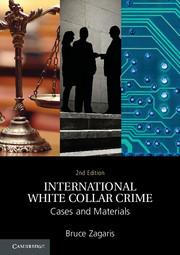Book contents
- Frontmatter
- Contents
- Preface
- 1 Introduction
- 2 Taxation
- 3 Money Laundering and Counterterrrorism Financial Enforcement
- 4 Transnational Corruption
- 5 Transnational Organized Crime
- 6 Export Control and Economic Sanctions
- 7 International Environmental Crimes
- 8 International Securities Enforcement
- 9 Extraterritorial Jurisdiction
- 10 International Evidence Gathering
- 11 Extradition and Alternatives
- 12 International Prisoner Transfer
- 13 The United Nations
- 14 The World Bank Group
- 15 INTERPOL
- 16 Economic Integration and Business Crimes
- Index
- References
5 - Transnational Organized Crime
Published online by Cambridge University Press: 05 November 2015
- Frontmatter
- Contents
- Preface
- 1 Introduction
- 2 Taxation
- 3 Money Laundering and Counterterrrorism Financial Enforcement
- 4 Transnational Corruption
- 5 Transnational Organized Crime
- 6 Export Control and Economic Sanctions
- 7 International Environmental Crimes
- 8 International Securities Enforcement
- 9 Extraterritorial Jurisdiction
- 10 International Evidence Gathering
- 11 Extradition and Alternatives
- 12 International Prisoner Transfer
- 13 The United Nations
- 14 The World Bank Group
- 15 INTERPOL
- 16 Economic Integration and Business Crimes
- Index
- References
Summary
Introduction
Organized crime is difficult to define. In 1919, the Chicago Crime Commission began referring to certain patterns of behavior as “organized crime,” and in 1929, U.S. President Herbert Hoover talked about the concept.
In 1975, the United Nations Crime Prevention and Criminal Justice Branch invoked the term “transnational crime” to identify certain criminal phenomena transcending international borders, transgressing laws of several states, or having an international impact. Until the 2000 passage of the Palermo Convention, “transnational crime” and “transnational organized crime” (TOC) were largely criminological terms used to discuss a crime with different definitions in different states, but that transcended the jurisdiction of a given state.
In 1994, the UN Secretariat, as part of the Fourth UN Survey of Crime Trends and Operations of Criminal Justice Systems, identified eighteen categories of transnational – and mostly organized – criminality: money laundering; illicit drug trafficking and corruption and bribery of public officials; infiltration of legal business; bankruptcy fraud; insurance fraud; computer crime; theft of intellectual property; illicit traffic in arms; terrorist activities; aircraft hijacking; sea piracy; hijacking on land; trafficking in persons; trade in human body parts; theft of art and cultural objects; environmental crime; and other offenses committed by organized criminal groups.
On December 15, 2000, the U.S. National Security Council issued a report outlining the impact of transnational crime on U.S. and international strategic interests. According to the report, international criminal networks – including traditional organized crime groups and drug traffickers – have exploited dramatic changes in technology, international politics, and the global economy to operate in a more sophisticated, flexible fashion. Globalization has given rise to more professional criminals who quickly adapt to market changes. Criminal organizations are networking and cooperating, merging their expertise, and widening the scope of their activities. By cooperating, many criminal organizations reduce the risks and costs of pursuing criminal opportunities.
- Type
- Chapter
- Information
- International White Collar CrimeCases and Materials, pp. 168 - 211Publisher: Cambridge University PressPrint publication year: 2015



